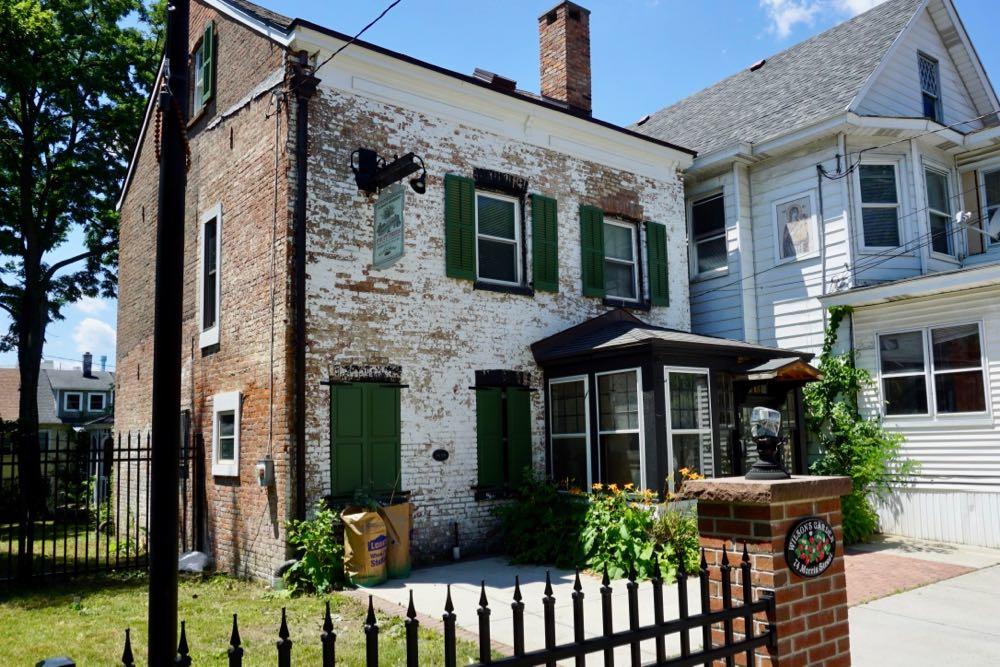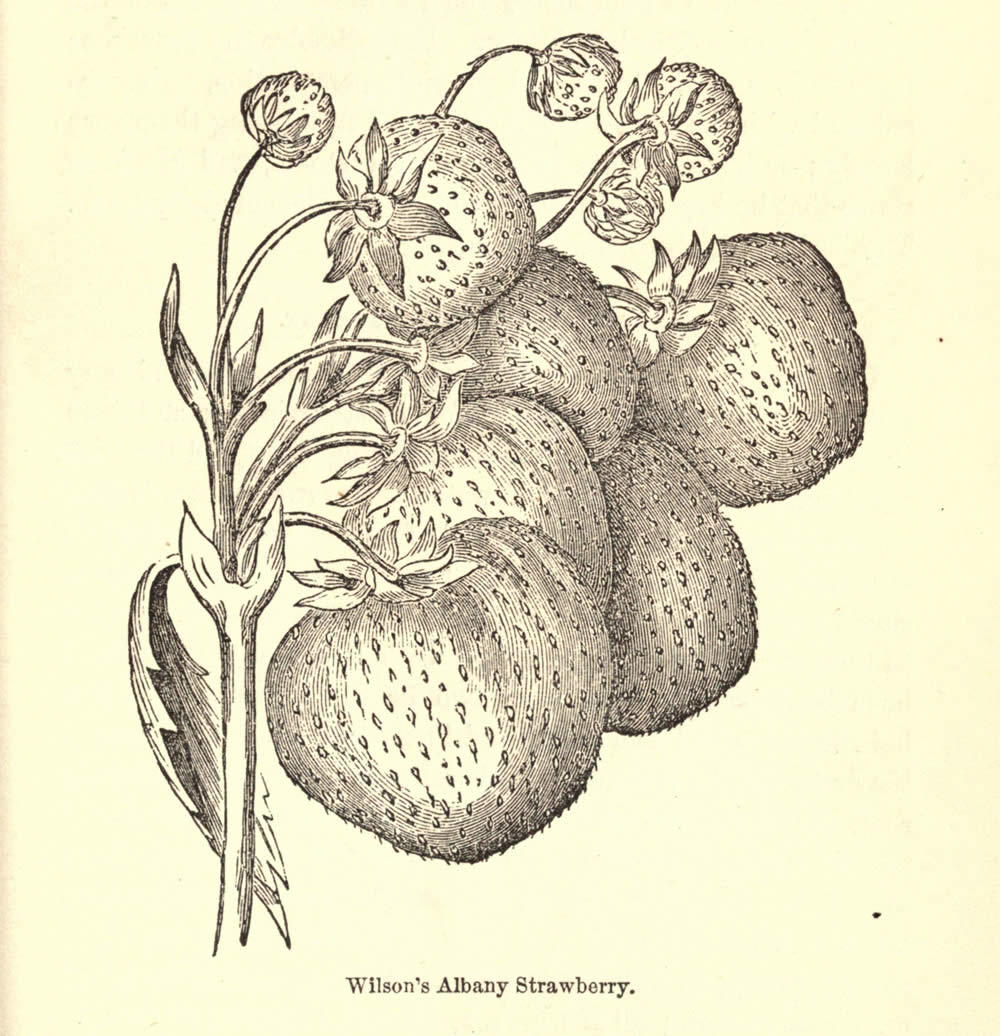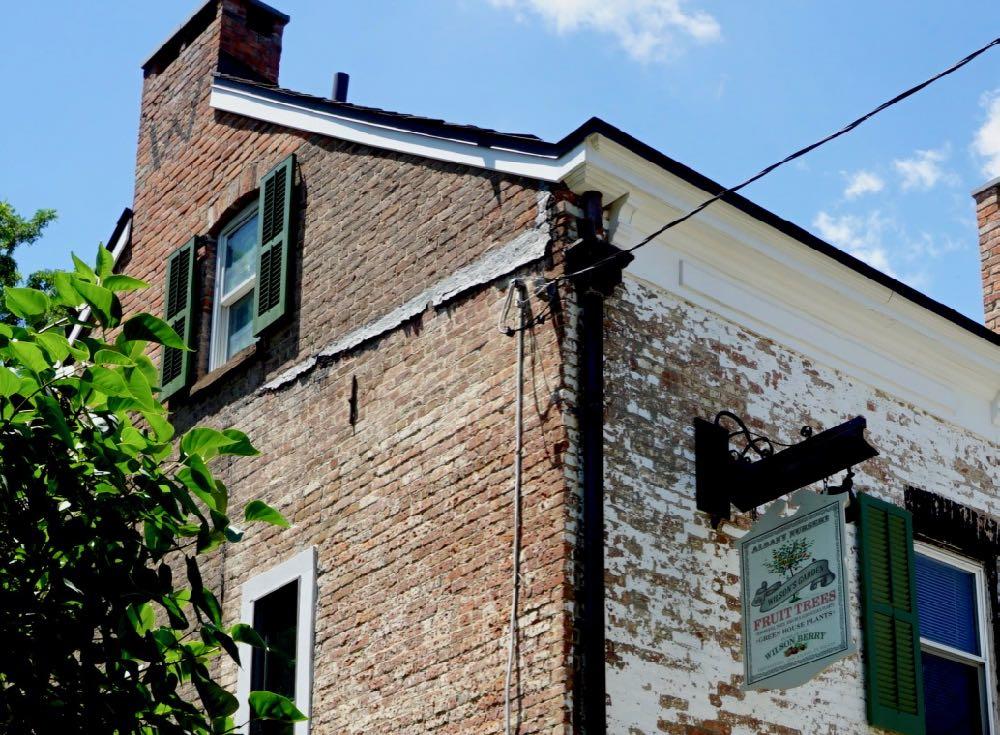How a strawberry grown from a "wasteland" in Albany helped spread a national strawberry craze

At the corner of Morris and Knox next to a small neighborhood park stands a two-story brick building, its front bearing a worn coat of paint. Built in 1838 in the Federal Style, it's the oldest still-standing building in Albany's Park South neighborhood.
But maybe more notable than its age is the fact that home and the land around it played a vital role in the growth of the strawberry trade in the United States, helping to set off a "strawberry fever."
This is the story of 74 Morris Street and The Wilson's Albany strawberry.
An undeveloped "wasteland" ripe for use

From the 1857 E. Jacob map of Albany. You can click the image for a closer look. / via NYPL
The area that would later make up the Knox Street Historic District and Park South neighborhood was much different in the 19th century than what it looks today. In the early 1800s, this area was undeveloped with several rolling hills and the Beaver Kill ran through it. Lydius Avenue (now known as Madison Avenue) was also present during the early 1800s. The name "Lydius" refers to the Lydius family, which was prominent in Albany society during the 17th century.
In 1813, Knox Street appeared on city maps running north-south through the area that would become Washington Park, then known as Washington Square and used for the next several decades as a parade ground for public functions.
According to the National Register of Historic Places registration form for the Knox Street Historic District that was filed with the United States Department of the Interior in 2008, it wasn't until the 1830s that James Wilson, a Scottish immigrant, took an interest in the land located south of Madison Ave between present-day Myrtle Avenue and Morris Street and stretching west to New Scotland Avenue -- land the city of Albany reportedly considered to be a "wasteland."
Wilson purchased this land in 1838. City assessment rolls listed 74 Morris Street as Wilson's residence for that year. In addition, it was reportedly the first and only residence in the area south of Madison Avenue for three decades. Wilson would also build several greenhouses.
Wilson's Albany strawberries

From the 1869 The American Gardener's Assistant by Thomas Bridgeman and S. Edward Todd. / via Wikipedia
Strawberries were one of the crops that Wilson chose to grow on "the wasteland" that he now owned. During this time the commercial strawberry industry in North America was "insignificant," according to Stevenson Whitcomb Fletcher's The strawberry in North America; history, origin, botany, and breeding. Yet over the next decade, Wilson would go on to completely change the industry.
How did he do this?
As detailed by George McMillan Darrow in The Strawberry: History, Breeding and Physiology, Wilson had planted open-pollinated seeds from a field with three varieties of strawberries that traced their lineage to England. And it was from one of those seeds that a special plant emerged.
Until 1850 strawberry plants in the United States were largely the result of cross breeding North American wild varieties with a large-fruited Chilean variety. But this breed of strawberry was not able to tolerate the North American climate except "under high, garden culture close to the coast. Other varieties were the result of European breeders trying to coax a commercial version out of North American wild varieties.
Wilson's chance strawberry was something different. It was hardy, growing well in this climate, not at all picky about its soil. And it produced large, beautiful, deep-red fruit -- in abundance -- that shipped well.
Wilson displayed his strawberries at a June 22, 1853 meeting of the Albany and Rensselaer Horticultural Society, as reported by Fletcher -- however, because his strawberries were just seedlings at the time they did not receive much attention from the the society's membership. That changed the next year when Wilson returned to the group with his fully-grown strawberries. According to Fletcher, the members of the horticultural society were astonished by the "size and number of the berries upon each plant."
Domination of strawberry industry

"Wilson's Albany" was a hit -- a strawberry plant that grew well, produced well, and its berries displayed well in markets. And, along with advances in transportation, it was a key inflection point in the history of the commercial strawberry industry.
By the 1860s and 1870s, the Wilson's became hugely popular, at one point representing 90 percent of the strawberry cultivation in the country, according to Fletcher.
And with this new, abundant supply of beautiful berries, the country found itself in the grips of a "strawberry fever." From a 1916 American Pomological Society journal looking back at the history of the strawberry industry:
"The introduction of the Wilson ushered in the boom period of American strawberry growing. The strawberry fever as it was called swept the country between 1858 and 1870 and reached its climax about 1865. Strawberries commonly sold in eastern cities for thirty to forty cents a quart and profits of $1,000 an acre were secured occasionally. In 1861 the editor of The Genesee Farmer visited Bloomington, Illinois and found Wilson strawberries selling for fifteen cents a quart and corn for eight cents a bushel. The inevitable reaction came about 1870 In many places prices declined to three or four cents a quart and hundreds of carloads were dumped into the Hudson River and Boston harbor. The business soon steadied down to moderate prices and fair profits except for a local recurrence of the strawberry fever in Florida from 1880 to 1892 when net profits of $3,000 an acre were reported from Bradford County and profits of $700 an acre were quite common."
A remarkable berry, except...

For all its attractive qualities, the Wilson's Albany had a catch: The fruit didn't taste that great.
Charles Hovey -- a Boston area nurseryman, horticultural writer, and major figure in the nation's early strawberry industry -- declared that Wilson's Albany strawberry was "one of the sourest, most dirty colored and most disagreeable flavored of all recently introduced sorts - an excellent sort to make vinegar of."
And Henry Ward Beecher -- the clergyman, social reformer, and abolitionist (and brother of Harriet Beecher Stowe) -- found himself moved to speak against the berry... because he couldn't help himself against it. Again from Fletcher's The strawberry in North America, a passage attributed to Beecher:
"I shall not feel easy in my mind till I have had my say about the Wilson's Albany. This vixenish berry is enough to turn a horticulturist's heart against his kind. It is the wickedest berry that was ever indulged with liberty. It is an invention by which the producers make money out of the consumer's misery. It has every quality of excellence except in the matter of eating. It bears prodigal crops of large-sized fruit, and is unfailingly sure. Now, is it not a thousand pities that such a berry should be of a nature so acid as to be a perfect virago among strawberries? It might live in a sugar bowl, and be acerb and crabbed still. It vexes me to pass by the fruit stands and see boxes and baskets of Wilson's Seedling outnumbering all others, and so large, plump, rich in color, and tempting that, with all my knowledge of its worthlessness, I am still tempted to buy. Let a man chew the rind of a shattuck, and imagine that it is an orange; let him eat cranberries, and call them sugar plums; and then let him eat Wilson's Seedling, and say, 'I have eaten strawberries.' I call upon the Society for the Prevention of Cruelty to Animals to unite with me, and with all rational beings, in suppressing the Wilson's Albany Seedling Strawberry."
Even so, the Wilson's Albany continued to dominate the field for the next two decades until it was gradually surpassed by varieties even easier to grow -- and better tasting.
A cash crop... for others

Note the "W" in the chimney.
Through skill and luck James Wilson helped grow the modern commercial strawberry industry from a patch of wasteland in Albany. But he didn't live to see the full rise of his creation, nor did his family reap a large share of wealth from the resulting strawberry madness. Once more from The strawberry in North America:
James Wilson was a nurseryman, so he must have realized the value of his seedling and the profit that might be derived by keeping it himself for exclusive propagation and sale; yet he generously divided his stock of plants with his neighbors. Two years later, when demands for plants began to pour in, he had fewer plants to sell than some of his neighbors, and realized very little profit. He died in 1855, leaving the nursery to his son, John Wilson, who continued to propagate the Wilson strawberry for several years. James Wilson was an unassuming man, who unselfishly declined to take advantage of an opportunity for private gain. Granville Cowing has declared, "The fruit growers and fruit consumers of this country owe him a debt far greater than many that have been paid in costly monuments of bronze and marble."
Wilson's former home on Morris Street is a residence today, according to city records. And a sign hangs from the second story: "Wilson's Garden ... Home of The Wilson Berry."
See also:
+ Carl Johnson's short history of the the Wilson's Albany at Hoxsie.
+ This Friends of Albany History post about Wilson's Nursery
Justin Devendorf is a resident of the Pine Hills neighborhood of Albany. He currently goes to Albany Law School and created the Photozofalbany Instagram page, where he shares the history and beauty of New York State's capital city and the surrounding region one post at a time.
Say Something!
We'd really like you to take part in the conversation here at All Over Albany. But we do have a few rules here. Don't worry, they're easy. The first: be kind. The second: treat everyone else with the same respect you'd like to see in return. Cool? Great, post away. Comments are moderated so it might take a little while for your comment to show up. Thanks for being patient.
Comments
So glad y'all wrote this! I've passed this sign many times and always wondered the story behind it. Thank you! Very interesting!
... said Sarah on Jul 5, 2018 at 2:18 PM | link
So glad to see interest in the property. My mother would be proud to see the work that has been put into her family home. We always had strawberries growing in the yard. Thank you for the spotlight on my childhood home.
... said Sharon Gates on Jul 5, 2018 at 8:27 PM | link
I grew up around that area, walked past that home any times and never knew any of this. Thank you so much!
... said Cynthia campbell on Jul 6, 2018 at 10:18 AM | link
Awesome story and so well researched and thorough... thank you! Please share more like this!
... said Burnt My Fingers on Jul 6, 2018 at 5:35 PM | link
I'm late in reading this....what's the story about the house? is it occupied or are there plans in the hopper to put it to good use?
... said jsc on Jul 6, 2018 at 11:05 PM | link
Justin,
Such an interesting article!
Always thrilled to read your work!
... said Lisa D on Jul 8, 2018 at 6:05 PM | link
What a great story. I knew the Gates and Harrison’s who loved the house and the neighborhood for many years. I’ll remember your fascinating story every time I eat another strawberry. Thanks to you and the Wilsons.
... said Jack McEneny on Jul 10, 2018 at 8:07 AM | link
Thank you so much everyone for the positive feedback! I look forward to writing more posts for All Over Albany!
... said Justin Devendorf on Jul 13, 2018 at 5:53 PM | link